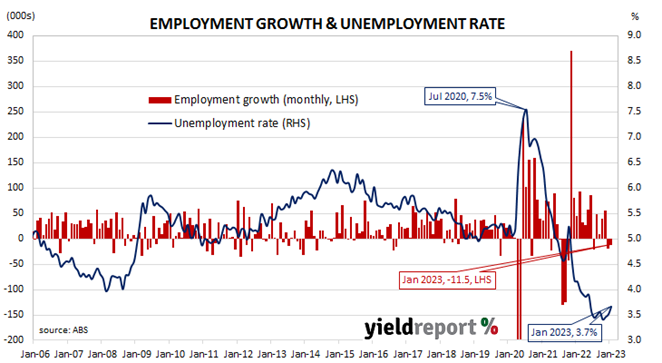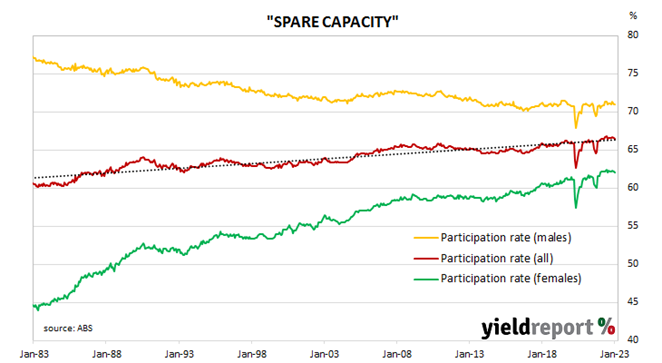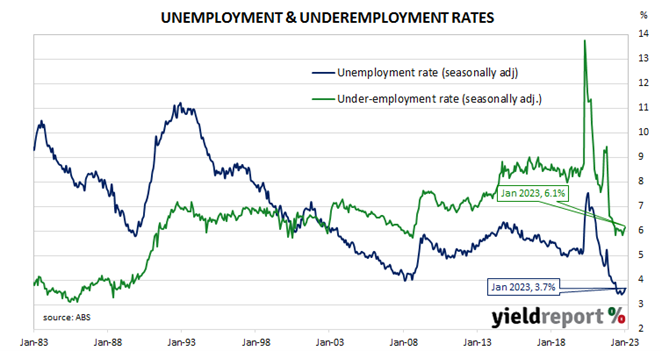Summary: Employment down 11,500 in January, contrasts with expected gain; NAB: employment “much stronger” than headline; Westpac: more data required before accepting softer trend concept; participation rate declines to 66.5%; jobless rate up from 3.5% to 3.7%; more part-time, fewer full-time jobs; aggregate work hours down 2.1%; underemployment rate steady at 6.1%.
Australia’s period of falling unemployment came to an end in early 2019 when the jobless rate hit a low of 4.9%. It then averaged around 5.2% through to March 2020, bouncing around in a range from 5.1% to 5.3%. Leading indicators such as ANZ’s Job Ads survey and NAB’s capacity utilisation estimate suggested the unemployment rate would rise in the June 2020 quarter and it did so, sharply. The jobless rate peaked in July 2020 but fell below 7% a month later and then trended lower through 2021 and 2022.
The latest Labour force figures have now been released and they indicate the number of people employed in Australia according to ABS definitions decreased by 11,500 in January. The fall contrasted with the 20,000 increase which had been generally expected but it was smaller than December’s 19,900 loss after revisions.
“January employment was much stronger than the headline, and we caution not to read too much into the softness implied by today’s figures,” said NAB economist Taylor Nugent. “A larger number of people than usual were ‘waiting to start work’ and so not yet counted as employed.”
Shorter-term domestic Treasury bond yields declined while long-term yields rose on the day. By the close of business, the 3-year ACGB yield had lost 2bps to 3.46% while 10-year and 20-year yields both finished 2bps higher at 3.77% and 4.10% respectively.
In the cash futures market, expectations regarding future rate rises over the next few months softened. At the end of the day, contracts implied the cash rate would rise from the current rate of 3.32% to average 3.485% in March and then increase to an average of 3.845% in May. August contracts implied a 4.095% average cash while November contracts implied 4.09%.
Westpac senior economist Justin Smirk generally agreed with his NAB counterpart and pointed to “some factors that would make you want to see more data before you accept the past few months being indicative of a new softer trend.”
The participation rate slipped from December’s figure of 66.6% to 66.5% as the total available workforce increased by 10,400 to 14.245 million while the number of unemployed persons increased by 21,900 to 523,200. As a result, the unemployment rate increased from 3.5% to 3.7%.
The aggregate number of hours worked across the Australian economy decreased by 2.1% as 31,800 residents gained part-time positions and 43,300 residents lost full-time positions. On a 12-month basis and after revisions, aggregate hours worked increased by 9.2% as 44,400 fewer people held part-time positions and 434,400 more people held full-time positions than in January 2022.
In recent years, more attention has been paid to the underemployment rate, which is the number of people in work but who wish to work more hours than they do currently. January’s underemployment rate remained steady at 6.1% after revisions, 0.3 percentage points above this cycle’s low.
The underutilisation rate, that is the sum of the underemployment rate and the unemployment rate, has a strong correlation with the annual growth rate of the ABS private sector wage index when advanced by two quarters. January’s underutilisation rate of 9.8% corresponds with an annual growth rate of about 4.4%.




